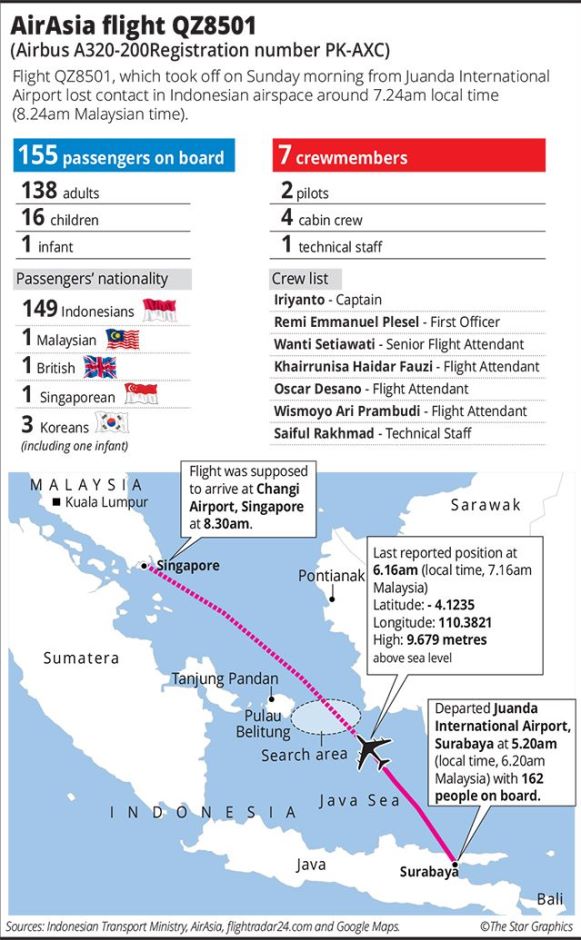Missing AirAsia flight QZ8501: Plane in good condition

LONDON/PARIS - The AirAsia plane that went missing on Sunday is young by commercial aircraft standards. It has also worked hard and lacks real time engine diagnostics, in accordance with its role as a short-haul aircraft.
Indonesia AirAsia Flight QZ8501, an Airbus 320-200 with 162 people aboard, lost contact with Jakarta air traffic control at 6:17 a.m. (2317 GMT) after taking off from Surabaya airport in Indonesia bound for Singapore, officials said. The pilots had asked to change course to avoid bad weather.
The Airbus A320-200 was delivered to its operator in 2008. It had recorded 23,000 flight hours on 13,600 flights, manufacturer Airbus said in a statement.
Those figures make the plane between six and seven years old against an industry lifecycle standard of 25 years, operating on a work cycle averaging more than six flights a day since it began service.
The aircraft's engines were made by French-American venture CFM International, co-owned by General Electric and Safran.
AirAsia subscribes to a GE maintenance service that may include real-time diagnostics or monitoring, according to the GE website.
Such systems are mainly used on long haul flights and can provide clues to airlines and investigators when things go wrong. A GE spokesman told Reuters: "This particular aircraft did not have the real-time remote engine diagnostics service".
AirAsia said the aircraft had undergone its last scheduled maintenance on Nov. 16.
More than 6,000 A320-200s are in service. They are designed to be used intensively on short routes and compete with the Boeing 737.
Earlier in December, the European Aviation Safety Agency (EASA) ordered a change in procedure for all A320 jets after computers onboard a similar A321 aircraft thought it was about to stall and pushed the nose downwards -- which is the standard way of preventing an upset -- just as pilots were trying to level off after climbing to their intended cruise height.
The incident happened after certain sensors iced up in bad weather. It is thought to be the only one of its kind since the A320 entered service in 1988, but resulted in a special bulletin to operators from Airbus, which was later made compulsory by EASA.
In the worst scenario, pilots would not be able to stop the automatic reaction, which could result in loss of control of the airplane, EASA said.
So far there is no indication what may have caused the AirAsia jet to go missing. Statistically, most accidents get blamed on a combination of factors, and it is rare for accident reports to isolate one single cause.
Commercial web tracking data suggested Flight QZ8501 had been in level flight for some time when it disappeared from radar, rather than at the top of the climb when the reported anomaly -- although rare -- is most likely to take place.
An Airbus spokesman declined to comment on the EASA directive, saying it was too early to speculate ahead of any investigation.
France's BEA crash investigation agency, which assists in the investigation of any air crash involving an Airbus aircraft because the company is France-based, said it was sending two officials to Jakarta accompanied by two experts from Airbus.
The US-based National Transportation Safety Board said it was monitoring the search for the plane and stood ready to assist Indonesia if needed.
